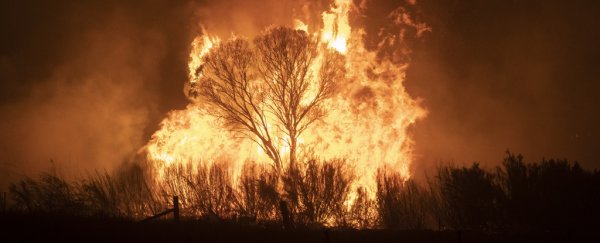Australia's horrific bushfires from late 2019 to early 2020 were like nothing the nation had ever seen. Multiple megafires blazed across the land, destroying forests, ravaging wildlife, and choking much of the country with dark clouds of acrid smoke.
The health toll of that unprecedented blanket of dangerous, particle-filled pollution is only now becoming clear, with a new study linking thousands of hospital visits and more than 420 deaths to the fires.
In new research, scientists compared the health impacts of smoke from last year's megafires – sometimes called Australia's Black Summer – against that of past bushfire seasons and found there basically was no comparison.
"We calculated the wildfire-smoke-related health burden and costs in Australia for the most recent 20 fire seasons and found that the 2019-20 season was a major anomaly in the recent record," the team, led by environmental health researcher Fay Johnston from the University of Tasmania, explains in a new study.
In financial terms, the team's modelling suggests smoke-related health costs from the 2019-20 bushfire season came to about A$1.95 billion (US$1.43 billion) – close to four times the next highest estimate of approximately A$566 million (US$414 million) in 2002-03.
Not only that, but these most recent health costs were more than nine times higher than the median of the previous 19 fire seasons (A$211 million or US$154 million).
Assessing the smoke burden in terms of economic costs is an important and necessary step for researchers and planners, especially as the climate crisis deepens around the world, leading to fires and fire seasons that are getting worse as the world gets hotter and drier.
"Landscape fires are an inherent feature of the ecology of many forested landscapes around the world," the team writes.
"However, the global trend of longer fire seasons with more extreme fire weather is leading to fires that are historically unusually frequent, severe and, in some cases, economically destructive, a trend that is likely to worsen according to climate projections."
Of course, the real tragedy – in terms of the burden on human health – can't be measured with dollar signs, but with what excessive levels of smoke did to people who had to breathe it in (not to mention the potential effects on unborn foetuses).
"Population exposure to wildfire smoke in the 2019-20 fire season alone was estimated to be associated with 1,523 asthma ED presentations, 2,092 admissions to hospital for respiratory conditions, 1,138 admissions for cardiovascular disorders and 429 premature deaths," the researchers write.
The researchers acknowledges that their estimates – based on public records of air quality data during the 2019-2020 event – are subject to a range of assumptions and uncertainties, but they also point out that the links between breathing in PM2.5 matter (ultra-fine pollution particles less than 2.5 micrometres in size) and adverse health effects are well established.
This kind of inhalable pollution is an inevitable by-product of bushfires, but the downstream health impacts of smoke exposure don't always show up in economic assessments of such disasters, the team says, compared to the more obvious and immediate effects of costs related to fire-related injuries, infrastructure losses, and fire suppression.
Given the worsening situation of climate change, however – and the fact that these sorts of megafires can happen in multiple places around the world, including in the western US most recently – coming to terms with the health burden is a "global policy challenge" we mustn't ignore, the researchers say.
"The direct and manifest health impacts of wildfires on large human populations are a powerful reason to improve climate change mitigation and achieve sustainable wildfire management," the authors conclude.
The findings are reported in Nature Sustainability.
